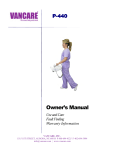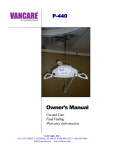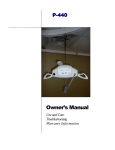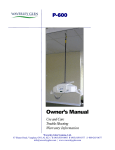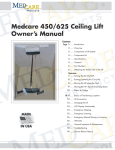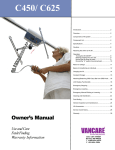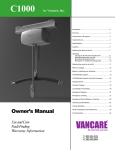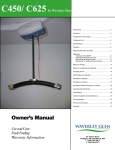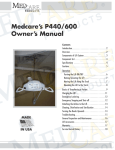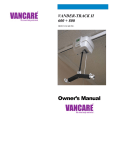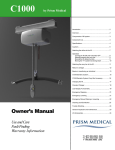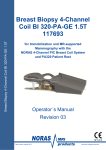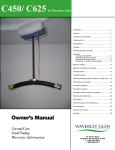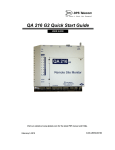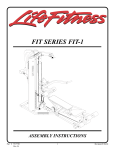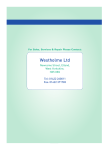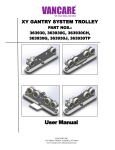Download P-600 User Manual WGS 31MAY2011
Transcript
P-600 Owner’s Manual Use and Care Troubleshooting Warranty Information VANCARE, Inc. 1515 1st St Aurora, NE 68818 1 (800) 694-4525 www.vancare.com Table of Contents P-600 Lift Introduction........................................................................................... 3 Overview ................................................................................................ 3 Components of lift system ............................................................... 4 Component List ....................................................................................5 Specifications....................................................................................... 5 Cautions ................................................................................................. 7 Operation Turning the lift ON/OFF............................................................... 8 Raising/lowering the lift .............................................................9 Moving the lift along the track .................................................... 10 Mounting the lift to the track .................................................11 Basics in transferring an individual ............................................ 12 Charging the lift .................................................................................14 Emergency Lowering ....................................................................... 15 Emergency Stopping and Shut-Off ……………...………………….15 Attaching the airline to the lift .....................................................16 LCD Display Functionality .............................................................17 Cleaning, Disinfection and Sterilization ...................................19 Turning the Hooks Upwards .........................................................19 Trouble Shooting ...............................................................................20 General inspection and maintenance .........................................21 Lift accessories .................................................................................22 Service record history .....................................................................23 P600 Lift- User Guide Page: 2 Rev: 17 JAN 2014 CAUTION: DO NOT ATTEMPT TO USE THIS EQUIPMENT WITHOUT FIRST UNDERSTANDING THE CONTENTS OF THIS MANUAL. Introduction Before using this equipment, and to ensure the safe operation of your P-600 lift carefully read this entire manual, especially the section on “Cautions”. The P-600 is designed to be used in conjunction with 9DQFDUH lift track, accessories and slings. Please refer to any user guides supplied with these components and reference them while reviewing this manual. Should any questions arise from reviewing this manual contact your local authorized 9DQFDUH dealer. Failure to comply with warnings in this manual may result in injury to the operator, or the individual being lifted/transferred. Damage to the lift and/or related components may occur. Be sure that the contents of this manual are completely understood prior to using this piece of equipment. Store this manual with the documents included with the lift system and sling (s). Contents of this manual are subject to change without prior written notice. Overview of P-600 lift system The P-600 lift is a lifting aid used by health care professionals and those providing care in the home to lift, position and transfer clients or a disabled family member. The P-600 lift is part of what is termed ceiling lift technology which takes advantage of lifting from above and not from below or the side. Additionally the ceiling lift does not take up valuable floor space as most traditional methods do. Finally, the ceiling lift makes it possible to move mobility impaired individuals with minimal strain or risk to the caregiver, while providing complete safety, dignity and comfort for the client or family member. The P-600 lift is one of four major components that make up this technology. The other three components are the track, trolley and sling. The P-600 lift runs on the lift track which is securely mounted to the ceiling structure of the institution, or home with the use of ceiling brackets. The track itself is made of specially designed aluminum and comes in many different shapes, lengths and configurations, and is custom tailored and installed to meet your specific requirements. The third component, the sling, is a specially designed fabric accessory that attaches to the lift by means of a integral carry bar and straps, and holds an individual while the lift, positioning or transfer takes place. The fourth component, the trolley, is mounted inside the track and has wheels that allow the lift to move along the track. The lift attaches to the trolley by means of the eyelet of the trolley. The track, trolley and sling are supplied with the lift at the initial time of purchase. The P-600 lift is a portable ceiling lift. It is designed to be easily moved from one track location to another. Track are typically installed in the bedroom, bathroom and/or the living room. The P-600 lift has the ability to lift an individual up from one location such as bed, move the individual along the track to another location and finally lower the individual into a chair or bathtub. It is moved along the track manually with the aid of a caregiver. The functions of lifting up or down are accomplished by pressing the buttons of a pneumatically (air) operated hand control. The hand control is attached to the lift by way of a rubber airline tubing. The P-600 lift is powered by batteries and it is supplied with an easy to use battery charger. Please refer to figure 1A to see a sample floor plan of an installed lift system and figure 1B to see a photo of the P-600. Refer to figures 2A, 2B, and 3 to familiarize yourself with the components of the P-600 lift, and charger. P600 Lift- User Guide Rev: 17 JAN 2014 Page: 3 Components of the P-600 Lift system BATH BATHROOM LIFT TRACK #1 BED TRACK #2 BEDROOM CUPBOARD Figure 1A - Sample floor plan showing basic components of a portable ceiling lift system. Figure 1B - P-600 Lift mounted onto track HAND CONTROL CARRY BAR HANDLE CARABINER HOOK LIFT TAPE CARRY HANDLE GROMMET INDICATOR LIGHT EMERGENCY LOWERING AIRLINE TUBE BUTTON UP BUTTON EMERGENCY SWITCH "DC" CHARGER CONNECTION DOWN BUTTON Figure 2A - Front View of P-600 lift Figure 2B - Back view of P-600 lift Figure 3 - Charger for P-600 lift P600 Lift- User Guide Page: 4 Rev: 17 JAN 2014 Component List The following components are included with your new P-600 lift system: P-600 lift • Pneumatic Hand Control • Lift Charger • Owner’s Manual • Warranty Card SLINGS: If a sling has been supplied with the lift refer to the instructions included with the sling. ACCESSORIES: If additional accessories such as a turntable, or gate system, have been supplied with the lift refer to the instructions included with those items. IMPORTANT: Before initial use, the lift unit must be charged for 5 hours. Refer to section titled "Charging Instructions". The hand control airline tube must also be connected to the lift. If it is not connected refer to the section titled “Attaching the airline to the lift”. Specifications of P-600 lift Lift Motor: Charger Input: Charger Output: Batteries: Lift Case: Hand Control: Lifting Range: Lift Weight: Maximum Load: Internal Fuses: Duty Cycle: Rated Performance: 24 VDC 100-240 VAC, 0.35 Amps 29.5 VDC, 1.3 Amps 24 VDC (2 x 12 VDC) 5.0 AH Flame Retardant ABS Pneumatic – Piston Displacement Up to 1.96m 23 lbs (10.432 kg) 600 lbs (274.28 kg) 15 Amp 1 min “ON”, 9 mins “OFF” 5-10 lifts at 600 lbs, 10% duty cycle, each lift being 24 inches at the middle of the lifting range (from 54” strap out to 30” strap out) per full battery Models Table for P-600 Lifts Code Description 303090 P-600 lift including charger and pneumatic hand control Shipping/Storage Conditions: Temperature: Shipping/Storage: -40 to +70 ºC Relative Humidity: Shipping/Storgage: 10 to 100% RH Atmospheric Pressure: Shipping/Storage: 500 to 1060 hPa P600 Lift- User Guide Page: 5 Rev: 17 JAN 2014 NOTES: · Please use the following type of plug for P-600 lifts installed in the UK: · Please use the following type of plug for P-600 lifts installed in Australia. · The P-600 lift shall be connected to a center-tapped single phase supply circuit when users in the United States connect the equipment to a 240 V supply system. Glossary of Symbols used in the P-600 Mark Symbol X X Reference IEC 604175172 Title C LASS II equipment Mark ISO 70000434 Caution risk of danger or Attention, consult X X Symbol Reference IEC 604175840 Title T YPE B APPLIED IEC 604175010 “ON” / “OFF” (pushpush) ISO 7010M002 Refer to instruction manual/booklet PART ACCOMPANYING D OCUMENTS X P600 Lift- User Guide IEC 604175665 BODY WEIGHT X Rev: 17 JAN 2014 Page: 6 Cautions ● The P-600 must be installed prior to use. Contact your local authorized dealer to ensure that it is properly installed. The P-600 must be installed only by persons authorized by 9DQFDUH ● Under no circumstance should the track, lift and sling (s) or entire system be put in control of a person who has not been properly trained in the use and care of this equipment. Failure to adhere to this warning may result in serious injury to the operator, and/or the individual being lifted/transferred. ● The P-600 lift and associated track and sling (s) are not toys. Do not use them for unsafe practices. Do not allow children to play with the lift or any of its components. ● The manufacturer's warranty is void if persons unauthorized by 9DQFDUH perform work on the P-600 lift system. ● There are no user serviceable parts inside the cover. Do not remove cover screws, or open the lift unit, as this will VOID THE WARRANTY. ● In facilities where more than one operator will be responsible for using the P-600 associated track and sling (s) it is imperative that all such members be trained in its’ proper use. A training program should be established by the facility to acquaint new operators with this equipment. ● Never expose the P-600 directly to water. Warranty does not cover any misuse or abuse of the lift system. ● To maintain optimum function, the P-600 should be inspected and maintained on a regular basis. See the section titled “General Inspection and Maintenance”. ● Any accessories used with the P-600, including track and sling (s), should be checked to ensure that they are in good working order. Check for signs of wear or fraying prior to use. Report any unusual wear or damage immediately to your local authorized dealer. ● The P-600 and associated lift, track and sling (s) are intended only for lifting and transferring of a person. 9DQFDUH will not be responsible for any damage caused by the misuse, neglect or purposeful destruction of the lift and/or its’ associated components. ● Do not in any circumstance exceed the maximum load of this lift. Refer to the “Specifications” section of this manual, and/or the labels on the side of the lift. ● The installation of the lift, track, accessories, and sling are certified to a maximum load. Do not exceed the maximum rated load of any of the components. ● There is a risk of explosion if the lift is used in the presence of flammable anaesthetics. ● Ensure that a clear space is maintained around the lift and track. Remove all curtain material and other obstacles out of the way before performing a transfer. P600 Lift- User Guide Rev: 17 JAN 2014 Page: 7 Rev: 17 JAN 2014 Rev: 17 JAN 2014 Basics in transferring an individual Caution: The following steps are intended to generally describe the procedure involved in the lifting and transferring of an individual from one location to another using the lift, track and sling. Track configurations will vary by installation. The manual for the sling that was purchased with the lift should be reviewed in detail prior to attempting these steps. Contact your local authorized dealer should you have any questions or concerns. Step 1) Carry the P-600 Lift to the desired transfer location. Set it on a secure object such as a table or chair. Let sufficient strap out of the lift so that the lift hook can be easily attached to the eyelet of the trolley without having to lift the lift. Attach the lift hook to the eyelet of the trolley as noted in the previous section titled “Mounting the lift to the track”. Lower the lift to a comfortable level so that it can easily be moved. Move it close to the individual that is to be transferred. Use the procedures for up and down and moving along the track as described in the previous sections titled “Raising/Lowering the lift” and “Moving the lift along the track”. Caution: Always be cautious when raising or lowering the lift, or moving the lift along the track. Watch out for and avoid any obstructions that may cause injury to the lift. Step 2) Prepare the individual being transferred with the appropriate sling. Refer to the instructions supplied with the sling that was purchased on how to properly outfit an individual with a sling. Caution: Always make sure that the sling is correctly fitted and adjusted on each side of the individual so that maximum comfort and safety are achieved prior to lifting. Refer to the sling instructions that were supplied with the sling. Step 3) Once the individual has been outfitted with the sling, move the lift so that it is positioned directly over the individual. The lift may need to be raised or lower ed, or r e-positioned along the track in order to accomplish this. Lower the lift so that the integral carry bar hooks are at a height that makes connecting the straps of the sling easy to accomplish. Steady the lift with one hand so that it does not accidentally come in contact with the head or body of the individual to be lifted. Caution: Always check to ensure that when the lift is lowered that it does come in contact with the person being lifted. Steady the lift with one hand while it is being lowered near an individual. Caution: Always check to ensure that the lift is correctly positioned directly above the person to be lifted. Over time, the lift strap may fray if this is not followed. Step 4) Following the instructions provided with the sling. Attach the straps of the sling to the car r y bar handles of the lift. The straps on each side of the sling are generally attached to the corresponding side of the carry bar hooks. Be sure to double check to ensure that the straps are properly attached to the carry bar hooks, and that the individual being lifted is properly positioned in the sling prior to lifting. P600 Lift- User Guide Rev: 17 JAN 2014 Page: 12 Caution: Prior to lifting an individual make sure that the straps of the sling are securely placed on the carry bar hooks and that the straps will not come off . A)- Sling loop correctly positioned at the base of the P-600 carry bar hook. B)- During the preparation for the patient transfer, the sling loop flipped over. Figure 4 - Load applied to the P-600 locking clip. The sling loop begins to slide off the hook locking clip. Figure 5 - Sling loop separated from the P-600 carry bar hook. Figure 3 - Sling loop incorrectly resting on the P-600 hook locking clip. Caution: There is a risk for the strap to disengage from the hook, if a sling loop is allowed to rotate and rest on the latch. Please check to ensure that the loops are on the hook not resting in the latch. Failure to adhere to these instructions could result in serious injury or death. For your safety and the safety of the patient, please always ensure that the sling loops are correctly positioned on the carry bar hooks. It is suggested to do the check of the sling loops once there is tension to the sling loops but prior to completely lifting the patient. P600 Lift- User Guide Rev: 17 JAN 2014 Page: 13 Charging the lift The batteries of the lift should be charged on a regular basis. It is recommended that the lift be left on charge when not in operation, and at the end of each day. This will maximize the life cycle of the batteries. The lift may remain connected to the charger indefinitely since the charger has a built-in regulator, eliminating the danger of overcharging. Step 1) Familiarize yourself with the basic components of the charging system. Refer to figures 12A and 12B. Figure 12A - P-600 lift and charger set on a secure table top or counter for charging. Charger “AC” wall plug Step 2) Place the lift and charger on a safe surface such as a table or counter top. The surface must be clean and dry, and away from the reach of a child. Step 3) Turn the lift OFF as described in the section titled “Turning the lift ON/OFF”. Indicator light Step 4) Plug the charger “AC” wall plug into a nearby wall outlet. The indicator light on the charger will turn GREEN. Plug Caution: Do not use an electrical extension to extend the reach of the “AC” wall plug. Charger “DC” output plug Figure 12B - Charger for P-600 lift Lift “DC” charger connection “DC” Charger output plug Figure 12C - Close-up of “DC” charger plug and lift “DC” charger connection. Note the 3 metal prongs on the end of the charger cord and 3 holes on the black “DC” connection. Figure 12D - Connect the charger to the lift. Be sure to line up the 3 metal prongs on the end of the charger with the 3 holes in the black lift “DC” connection. Figure 12E - Charger is connected to the lift. The indicator light on the charger will be ORANGE indicating that the lift is charging. Caution: The charger must be located outside the patient vicinity at all times. The patient vicinity is the space with surfaces likely contacted by the patient or an attendant who can touch the patient. This space is 6 feet (1.83m) beyond the perimeter of the bed, examination table, etc., extending vertically 7-1/2 feet (2.29m) above the floor. Step 5) Take hold of the charger “DC” output plug and visually observe that it has three (3) prongs inside of its metal case. These are designed to fit into the three (3) holes that are located on the black lift “DC” connection. Refer to figure 12C. Step 6) Take the charger “DC” output plug and connect it to the black lift “DC” connection being careful to ensure that the metal prongs from the charger plug fit into the holes of the black lift connector. When this is completed correctly, then the indicator light on the charger will turn ORANGE. Refer to figures 12D, E. Caution: Do not operate the lift while it is connected to the charger. After a minimum of 1 hour the charger can be disconnected from the lift, and the lift put into use. However overnight charging is recommended. Caution: Do not allow the batteries to become discharged below the low battery alarm, as this will decrease overall battery life and performance. Caution: Use only the charger that was supplied with the lift. Use of any other charger will void all warranties and may cause damage to the lift. P600 Lift- User Guide Page: 14 Rev: 17 JAN 2014 Emergency Lowering The DOWN blue button located on the front right side of the lift can be used to lower an individual should the hand control buttons fail. Refer to figure 14B. Figure 14A –Lift showing DOWN button located on front right side of lift. Figure 14B –RED emergency lowering button located on middle of the front of the lift. Should both DOWN arrow buttons on the hand control, and the DOWN button of the lift fail, the person may be lowered by pressing the RED emergency lowering button located on middle front side of the lift. There will be a delay of approximately 2 seconds before the lift starts to lower. An audible alarm will also sound during the emergency lowering. Refer to figure 14B. IMPORTANT: The Emergency Lowering system does not provide a raising function. The failure of any of the lowering device should be reported to your authorized dealer immediately. Emergency Stopping and Shut-off The lift normally shuts off if the lift has not been in use for 2 minutes. Should a situation present itself such that the lift will not respond to the hand control buttons or on any of the normal operational control buttons on the front of the lift then the RED Emergency stop switch should be switched to the “OFF “ position. This will shut off power going to the motor of ON/OFF Button Figure 14C –RED Emergency stop switch located on the front left side of the lift. ON Emergency OFF/STOP Figure 14D - Close-up of switch ON - Normal lift Operation OFF - Emergency Stop P600 Lift- User Guide the lift and will immediately stop all movement. Should the emergency stop function be used in an emergency, then before the lift can be used again, it must be inspected by an authorized dealer. Once the lift has been inspected and/or repaired, then the Emergency Stop Button can be set to the “ON” position. Normal use of the lift may then proceed. Note: The lift will only charge if the Emergency stop switch is in the “ON” position. Refer to the section titled, “Charging the lift” for charging instructions. Rev: 17 JAN 2014 Page: 15 LCD Display & Programming Functionality • Default Display Modes: − The user can set either of the following as the ‘Default’ display mode: 1.– Battery Level (the factory setting for the Default Display Mode); or, 2.– Number of Lifts. − In Battery Level Mode the lift will: 1. Display the word, “Battery”, with the percentage charged (in 10% increments) in the top row of the display (e.g., “Battery Level 60%”). 2. Display a “Bar Graph” of the battery level in the second row of the display by displaying the appropriate number of fully blackened rectangles as in the following diagram (note: as there are 12 characters, the charge percentage will be divided by 8.333 and rounded DOWN to determine how many rectangle characters are shown): B a t t e r y 5 0 % − Note: As the lift is initially switched on, the level of battery charge displayed may be incorrect. However, as soon as the lift is actually operated, the charge level will update to the correct level. − In Number of Lifts Mode the lift will: 3. Display the word, “Lifts”, with the number of lifts completed in the top row of the display (e.g., “Lifts 500”) and a bar graph to indicate the battery level as in Battery Level Mode: L i f t s x x , x x x − In any ‘Default display mode’, if the battery levels fall below 25%, the lift will go into Low Battery Mode. The lift will then: 4. Make an audible beeping sound every ten (10) seconds. 5. The display should flash “Low Battery” in the first line. 6. The bars indicating charge level should flash on and off. Rev: 17 JAN 2014 LCD Display & Programming Functionality − In any ‘Default display mode’, if the unit is in the charger the lift will go into Charging Display Mode regardless what the user has selected as ‘Default Display Mode’. Charging Display Mode should over-ride Low Battery Mode. − The lift will then: 7. Display a flashing “Charging” with the percentage charged (in 10% increments) in the top row of the display (e.g., “Charging 60%”). 8. Show the appropriate number of fully blackened out cells, with the remaining cells in the bottom row flashing. C h a r g i n g 5 0 % Flashing Flashing • • • To enter programming mode: − Hold the ‘Up’ and ‘Down’ buttons simultaneously for three (3) seconds. − The lift will then: 9. Beep three (3) times. Display a flashing “Entering Programming Mode” for two (2) seconds. 10. Go to the first programming option. − If the user continues to hold the ‘Up’ and ‘Down’ buttons for longer than the display flashes, “Entering Programming Mode”, the unit will exit the programming mode. To exit programming mode: − If no buttons are pressed for ten (10) seconds the unit exits the programming mode automatically. The lift should then: 11. Beep three (3) times. (the beep should be as loud as the existing emergency down alarm) 12. Display a flashing “Exiting Programming Mode” for two (2) seconds. 13. Go back to the standard display mode. Programming Mode: − Whenever in Programming Mode, the top line of the display should read, “PROGRAM MODE”. Depending on what is being programmed, the second line should then change: P R O G R A M M O D E D i s p l a yx B A T − Using the ‘Up’ and ‘Down’ buttons, the user should then be able to cycle through their choices. 753101TM – C-450/C-625™ – Technical Manual Page: 27 Rev: 17 JAN 2014 Attaching the airline tube to the lift Should the gray rubber airline that connects the lift to the hand control become disengaged from the front left side of the lift it must be re-connected in order for the lift to work properly. The rubber airline may become disconnected for the following reasons: Figure 15A - Gray rubber grommet located on front right side of the lift. Rubber airline is not connected. Note ridge on grommet. 1) The lift is pulled along the track by the airline. 2) The tubing accidentally gets wrapped around an object while a lift or transfer is being performed. 3) It is accidentally pulled out by the caregiver or the individual being lifted. The airline is connected to a gray rubber grommet located on the front left side of the lift. Refer to figure 15A. Small metal ribbed pins located at the end of the airline hold the airline to this rubber grommet in a specific manner. Therefore it is important to make sure that the airline is connected properly. Both the gray airline and the rubber grommet have a ridge on one of their sides. Align the ridges for proper connection. Refer to figure 15B. When this is done then the metal ribbed pins attached to the end of the airline can be re-insert into the corresponding holes in the rubber grommet located on the front left side of the lift. Be sure to insert the pins into the gray rubber grommet sufficiently so that it is secure. Refer to figure 15C. Figure 15B - Gray rubber airline being inserted into rubber grommet of lift. The ridges on both pieces are lined up. The metal ribbed pins are on the airline (within the shroud). Perform a brief test of the lift to ensure proper connectivity. Turn the lift ON and OFF. Raise and lower the lift. If the lift does not work properly, check to ensure that the ridges on the gray rubber grommet on the underside of the lift and the airline tubing are lined up properly. If they are not lined up properly, then remove the airline, line up the ridges and then re-insert it into the rubber grommet. Perform the test as noted in the preceding paragraph. If there are still problems with the lift then contact your local authorized dealer for service. Figure 15C - Gray rubber airline being inserted into rubber grommet of lift. The ridges on both pieces are lined up. The metal ribbed pins are on the airline. P600 Lift- User Guide Rev: 17 JAN 2014 Page: 16 Trouble Shooting Should problems arise with the use of the P-600 lift review the following chart. Find the fault and complete the recommended solution. If the fault is not found and/or the solution does not correct the problem contact your local authorized dealer for service immediately. Fault Recommended Solution The airline tubing that connects the hand control to the lift has become disengaged. Refer to the section of this manual titled “Attaching the airline tube to the lift”. If this does not correct the problem then contact your local authorized dealer immediately so that the lift can be checked to ensure proper continued operation. The hand control buttons do not operate according to their designations (e.g. the UP button initiates a down movement). The airline tubing has not been connected correctly. Refer to the section of this manual titled “Attaching the airline and hand control to the lift”. If this does not correct the problem then contact your local authorized dealer immediately so that the lift can be checked to ensure proper continued operation. The lift does not operate up or down even when the airline has been properly connected. The indicator light on the front right side of the lift should be GREEN. Press the ON/OFF button or UP/DOWN arrow buttons on the hand control. This should activate the lift and the indicator light turn GREEN. If the lift still does not function, then the batteries may be low and require charging. Refer to the section of this manual titled “Charging the lift”. Charge the lift for at least one hour and then try to raise and lower it. The GREEN light on the left front There is a built-in slack tape detector in the lift. This may be sensitive. Take hold of the lift side of the lift is ON and the lift does strap about 10 centimetres above the top of the lift and pull it upwards in order to tighten the not operate in the DOWN direction. lift strap, and then press the DOWN button. If this corrects the problem temporarily but not permanently then contact your local authorized dealer so that the lift can be checked to ensure proper continued operation. The red indicator light on the left The batteries are low and require charging. Refer to the section of this manual titled front side of the lift turns RED and/or “Charging the lift”. Charge the lift for at least one hour and then try to raise and lower a loud alarm sound is heard when an it. individual is raised. If this does not correct the problem then contact your local authorized dealer immediately so that the lift can be checked to ensure proper continued operation. One side of the lift tape (strap) is starting to fray after continued use. Check to be sure that the lift is always directly above the individual being lifted. Refer to the section titled “Basics in transferring an individual” for correct lift positioning. If fraying still continues then contact your local authorized dealer immediately so that the lift can be checked to ensure proper continued operation. The lift does not pass through a track Refer to the “Owners Manual” for the specific piece of equipment in question. If the recomcomponent such as a turntable or mended solution does not correct the problem then contact your local authorized dealer imgate. mediately so that the lift can be checked to ensure proper continued operation. P600 Lift- User Guide Rev: 17 JAN 2014 Page: 20 General Inspection and Maintenance A) Each Use - To be completed by User Prior to each use the P-600 lift and associated track, accessories and sling (s), must be visually inspected. Refer to the accessory and sling user guides for specific details regarding their inspection. Should any of the these items fail the inspection do not use the lift Contact your local authorized dealer for service. Visually check for the following: The lift strap shows NO signs of fraying or breaking along its entire length. □ □ The stitching on the lift strap where it connects to the lift hook shows NO signs of fraying or breaking. □ The sling (s) that will be used show NO signs of unusual wear or damage. The straps of the sling that □ □ □ □ □ □ □ connect to the carry bar hooks of the lift show NO signs of fraying or breaking. The airline tube that connects the hand control to the lift is not kinked, twisted, knotted, cut or damaged. All the functions on the hand control work correctly (e.g. UP/DOWN). The brackets that hold the track in place on the ceiling are secure and do not move or appear loose. The lift has no unusual sounds when it is moved UP/DOWN or along the track.. Ensure that there are end stops installed at each end of the track. There are not cuts, dents or sharp edges on the carry bar hooks that may damage straps of the sling. The carabiner hook shall be visually inspected before and after each lift for damages. B) Monthly - To be completed by User Should any of the these items fail the inspection do not use the lift. Contact your local authorized dealer for service. □ Complete the visual inspection as noted in the “Each Use” section above. With no one in the sling nor attached to the lift check the following: □ The lift moves freely along the entire length of the track. C) Semi-Annual or Yearly - To be completed by a lift technician Consult your local authorized dealer for advice on whether this section should be completed every 6 months or on a yearly basis. Generally, in frequent use, or in situtations where heavier than normal clients are lifted, or in multi-user environments such as in institutions the lift should be checked every 6 months. □ Complete the visual inspection as noted in the “Monthly” section above. This section to be only completed by a qualified service technician as authorized by 9DQFDUH □ Lift checked and passed. Any required repairs completed. P600 Lift- User Guide Rev: 17 JAN 2014 Page: 21 Lift Accessories The following is a list of available accessories for the P-600 lift. Items such as the track, turntables and brackets are installed at the time of purchase. Add-on pieces are available to after the initial purchase, however your local authorized dealer must be consulted as to suitability, purchase and installation. Slings are the most common after purchase accessory. A variety of styles, sizes, and colors are available. Custom slings can also be manufactured to meet special needs. Consult your local authorized dealer for details, pricing and a complete list of current sling models. TRACK 1.82MTR (6FT) LENGTH 2.5MTR (8FT) LENGTH MAY BE CUT AT TIME OF INSTALLATION TRACK 5.0MTR (16FT) LENGTH MAY BE CUT AT TIME OF INSTALLATION TRACKPLUS TRACK 5.0MTR (16FT) LENGTH 6.0MTR (19FT) LENGTH MAY BE CUT AT TIME OF INSTALLATION TRACK TRANSGATE SYSTEM 90 DEGREE CURVE MAY BE CUT AT TIME OF INSTALLATION TRACK 45 DEGREE CURVE MAY BE CUT AT TIME OF INSTALLATION TRACK END STOP "H" SYSTEM TROLLEY SET USED ONLY WITH "H" FRAME AREA COVERING SYSTEM MULTI-PORT TURNTABLE SYSTEM WALL MOUNT BRACKET 3" TRACK BRACKET REACHER VARIOUS STYLES AND SIZES OF SLINGS. CUSTOM SLINGS AVAILABLE. QUICK FIT TURNTABLE SYSTEM 6" TRACK BRACKET EXTENDED CARRY BAR ACCESSORIES NOT TO SCALE. FOR ILLUSTRATIVE PURPOSES ONLY. NOTICE: ACCESSORY SIZE, STYLE, SHAPE, LENGTH, CONFIGURATIONS, OPTIONS, COLOURS AND SPECIFICATIONS MAY CHANGE WITHOUT PRIOR WRITTEN NOTICE. CONTACT YOUR LOCAL AUTHORIZED DEALER FOR DETAILS. CAUTION: ONLY SLINGS AUTHORIZED BY 9$1&$5( ARE TO BE USED WITH THIS LIFT. CONTACT YOUR LOCAL AUTHORIZED DEALER FOR DETAILS. P600 Lift- User Guide Rev: 17 JAN 2014 Page: 22 Service Record History - Initial Information Complete the following section on Purchase and Service Information as soon as this equipment is installed. Use the service record history to record to any completed service and repairs. Ensure that the service record is signed and dated each time it is used. Be sure to have this piece of equipment serviced on a regular basis as described in the General Inspection and Maintenance Section PURCHASE INFORMATION: Product Name: Model: ____________________________ Serial#:________________________ P-600 lift Date of Purchase: _____________________ Date Installed: _________________ Purchased From: ___________________________________________________________ Address: _______________________________________ City: __________________________ Telephone No: __________________________ Postal Code: __________________ Comments: SERVICE INFORMATION: Contact the following company for service: Company: ___________________________________________________________ Address: _______________________________________ City: __________________________ Telephone No: Postal Code: _________________ __________________________ Comments: P600 Lift- User Guide Rev: 17 JAN 2014 Page: 23 Service Record History Date: _______________________ Service Type: □ Periodic Inspection Complete this section after each service, repair inspection and/ or maintenance. Photocopy additional pages as required. Time: ________________________ □ Monthly Inspection Completed By: _________________________ Printed Name □ 6 Month Inspection □ Repair □ Yearly Inspection □ Other:_________ _____________________________ Signature Company: _____________________________________________________________ Remarks & Action Taken: Date: _______________________ Service Type: □ Periodic Inspection Time: ________________________ □ Monthly Inspection Completed By: _________________________ Printed Name □ 6 Month Inspection □ Repair □ Yearly Inspection □ Other:_________ _____________________________ Signature Company: _____________________________________________________________ Remarks & Action Taken: Date: _______________________ Service Type: □ Periodic Inspection Time: ________________________ □ Monthly Inspection Completed By: _________________________ Printed Name □ 6 Month Inspection □ Repair □ Yearly Inspection □ Other:_________ _____________________________ Signature Company: _____________________________________________________________ Remarks & Action Taken: Date: _______________________ Service Type: □ Periodic Inspection Time: ________________________ □ Monthly Inspection Completed By: _________________________ Printed Name □ 6 Month Inspection □ Repair □ Yearly Inspection □ Other:_________ _____________________________ Signature Company: _____________________________________________________________ Remarks & Action Taken: Date: _______________________ Service Type: □ Periodic Inspection Time: ________________________ □ Monthly Inspection Completed By: _________________________ Printed Name □ 6 Month Inspection □ Repair □ Yearly Inspection □ Other:_________ _____________________________ Signature Company: _____________________________________________________________ Remarks & Action Taken: Date: _______________________ Service Type: □ Periodic Inspection Time: ________________________ □ Monthly Inspection Completed By: _________________________ Printed Name □ 6 Month Inspection □ Repair □ Yearly Inspection □ Other:_________ _____________________________ Signature Company: _____________________________________________________________ Remarks & Action Taken: P600 Lift- User Guide Page: 24 Rev: 17 JAN 2014 Service Record History Date: _______________________ Service Type: □ Periodic Inspection Complete this section after each service, repair inspection and/ or maintenance. Photocopy additional pages as required. Time: ________________________ □ Monthly Inspection Completed By: _________________________ Printed Name □ 6 Month Inspection □ Repair □ Yearly Inspection □ Other:_________ _____________________________ Signature Company: _____________________________________________________________ Remarks & Action Taken: Date: _______________________ Service Type: □ Periodic Inspection Time: ________________________ □ Monthly Inspection Completed By: _________________________ Printed Name □ 6 Month Inspection □ Repair □ Yearly Inspection □ Other:_________ _____________________________ Signature Company: _____________________________________________________________ Remarks & Action Taken: Date: _______________________ Service Type: □ Periodic Inspection Time: ________________________ □ Monthly Inspection Completed By: _________________________ Printed Name □ 6 Month Inspection □ Repair □ Yearly Inspection □ Other:_________ _____________________________ Signature Company: _____________________________________________________________ Remarks & Action Taken: Date: _______________________ Service Type: □ Periodic Inspection Time: ________________________ □ Monthly Inspection Completed By: _________________________ Printed Name □ 6 Month Inspection □ Repair □ Yearly Inspection □ Other:_________ _____________________________ Signature Company: _____________________________________________________________ Remarks & Action Taken: Date: _______________________ Service Type: □ Periodic Inspection Time: ________________________ □ Monthly Inspection Completed By: _________________________ Printed Name □ 6 Month Inspection □ Repair □ Yearly Inspection □ Other:_________ _____________________________ Signature Company: _____________________________________________________________ Remarks & Action Taken: Date: _______________________ Service Type: □ Periodic Inspection Time: ________________________ □ Monthly Inspection Completed By: _________________________ Printed Name □ 6 Month Inspection □ Repair □ Yearly Inspection □ Other:_________ _____________________________ Signature Company: _____________________________________________________________ Remarks & Action Taken: P600 Lift- User Guide Page: 25 Rev: 17 JAN 2014 Service Record History Date: _______________________ Service Type: □ Periodic Inspection Complete this section after each service, repair inspection and/ or maintenance. Photocopy additional pages as required. Time: ________________________ □ Monthly Inspection Completed By: _________________________ Printed Name □ 6 Month Inspection □ Repair □ Yearly Inspection □ Other:_________ _____________________________ Signature Company: _____________________________________________________________ Remarks & Action Taken: Date: _______________________ Service Type: □ Periodic Inspection Time: ________________________ □ Monthly Inspection Completed By: _________________________ Printed Name □ 6 Month Inspection □ Repair □ Yearly Inspection □ Other:_________ _____________________________ Signature Company: _____________________________________________________________ Remarks & Action Taken: Date: _______________________ Service Type: □ Periodic Inspection Time: ________________________ □ Monthly Inspection Completed By: _________________________ Printed Name □ 6 Month Inspection □ Repair □ Yearly Inspection □ Other:_________ _____________________________ Signature Company: _____________________________________________________________ Remarks & Action Taken: Date: _______________________ Service Type: □ Periodic Inspection Time: ________________________ □ Monthly Inspection Completed By: _________________________ Printed Name □ 6 Month Inspection □ Repair □ Yearly Inspection □ Other:_________ _____________________________ Signature Company: _____________________________________________________________ Remarks & Action Taken: Date: _______________________ Service Type: □ Periodic Inspection Time: ________________________ □ Monthly Inspection Completed By: _________________________ Printed Name □ 6 Month Inspection □ Repair □ Yearly Inspection □ Other:_________ _____________________________ Signature Company: _____________________________________________________________ Remarks & Action Taken: Date: _______________________ Service Type: □ Periodic Inspection Time: ________________________ □ Monthly Inspection Completed By: _________________________ Printed Name □ 6 Month Inspection □ Repair □ Yearly Inspection □ Other:_________ _____________________________ Signature Company: _____________________________________________________________ Remarks & Action Taken: P600 Lift- User Guide Page: 26 Rev: 17 JAN 2014 If you have any questions about the manufacture or operation of this equipment, please contact 9DQFDUH, or your local authorized dealer. Manufactured for: 9DQFDUH,QF VW6W $XURUD, 1( Telephone: () Fax: () P600 Lift- User Guide Rev: 17 JAN 2014 Page: 27 VANCARE Ceiling lift Skills Observation Assessment Staff Member Observed ___________________________________________ Date _____________ PROCEDURE - DID THE EMPLOYEE: Have the required number of staff members present? Select the correct size sling? Inspect the sling and lift for damage and proper operation? If DAMAGED, did the employee get another lift/sling and notify charge nurse? Correctly position the sling so that the bottom center of the sling is at the tailbone? Perform environment assessment and move objects that would impede operation of lift? Move the lift into position with the hanger bar in the “H” position in front of the resident? Lower the lift using the Pendant Switch? Connect the sling loops to the hanger bar hooks? Use the same loops on each side? Double check the sling attachment to the lift? Lift the resident only as high as necessary? Moving the lifter with a patient in the sling? Lower the lift until the resident is sitting on the chair or lying on the bed? Remove the sling loops from the hanger bar hooks, and prevent the hanger bars from coming in contact with the patient? Back the lift away from the resident and remove the sling? Make certain the resident is safe and comfortable before leaving? KNOWLEDGE – CAN THE EMPLOYEE: Identify lifting capabilities (maximum weight)? Identify location and use of Emergency Stop Switch? Identify location and use of Emergency Lowering? Identify location and use of Auxiliary Up/Down Switch? Identify Low Battery Indicator light and/or LCD Battery Display? Demonstrate how and when to recharge batteries? Use the Scale attachment properly? Identify sling parts: head support, shoulder loops, leg supports, leg loops, stabilizing handles? Demonstrate ability to adjust angle of recline to maintain hip precautions? Demonstrate transfer of patient, using Vancare ceiling lift, from bed to to chair, chair to bed, and floor to bed? Demonstrate proper understanding of how to clean the sling and lift? Refer to Operator’s Manual for more detailed description of transfer technique. Pass Fail Observations __________________________________________________________________ _____________________________________________________________________________ Observer’s Name _______________________________________________________________ Observer’s Signature ____________________________________________________________ VANCARE, INC 1515 FIRST STREET AURORA, NE 68818 PHONE: (800)694-4525 FAX: (402)694-3994 WEB: www.vancare.com




























